
9 minute read
Plumbing
Enjoy hot and cold water at the office Oasis International, Columbus, Ohio, has released the Aquarius convertible water cooler. It has a convection-cooled condenser and spring-mounted, hermetically sealed compressor which requires no lubrication. Refrigerant is controlled by a capillary tube and temperature is controlled by a pre-set thermostat. The cold-water reservoir is Type 300 series stainless-steel with an external refrigerant coil. Its one-piece hot tank has a 420-watt heating element, delivering oneand-a-half gallons of hot water per hour with a 0.95 litre storage tank. Oasis International
www.oasiscoolers.com
Liquid heating and cooling approved Badger Meter, Milwaukee, Wisconsin, announced its Dynasonics UHC100 ultrasonic thermal energy meter received Canada Weights and Measures approval for use in liquid heating and cooling applications. The UHC100 calculates energy quantity (gigajoules, kilo, or megawatt hours) by measuring the amount of liquid flowing through the flow sensor in a given timeframe, and the liquid temperature at the supply and return flow positions. Badger Meter
www.badgermeter.com
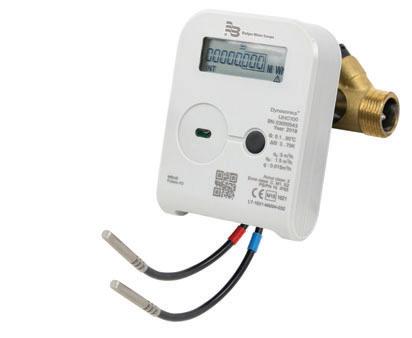
Backflow protection Milwaukee Valve, Milwaukee, Wisconsin, produces both “T” and “Y” pattern back-flow protection. The T-pattern swing check valve provides the most flow, while providing the necessary back-flow protection. It is available in both Class 125 and Class 150, with either bronze or PTFE seats. The Y-pattern check valve is designed with inline repairability in mind. It is available with bronze seats in Class 125, Class 150, Class 200, and Class 300. Milwaukee Valve
www.milwaukeevalve.com


Quiet variable speed system Goulds Water Technology, Rye Brook, New York, recently launched the e-HME and e-SVE pumps with integrated and variable speed control. The variable speed system combines a hydraulic pump with permanent magnet motor technology. The e-HME is available in five models and delivers up to 130 GPM and 540 ft. TDH. The e-SVE is available in six models and delivers up to 85 GPM and 710 ft. TDH. Xylem www.xylem.com Warm soak in the tub Barclay, Gurnee, Illinois, introduces the Ceres scooped 59-inch acrylic freestanding tub set on an unassuming base. The option to add foam insulation between the tub walls for a longer lasting soak is available. An overflow slot with an integrated drain is a new feature to the acrylic tub. White drain and overflow covers are included and a selection of custom colours are available. Barclay
www.barclayproducts.com

Limit mould in riser clamps Hydra-Zorb Company, Auburn Hills, Michigan, has received UL certification 2043 for its Titan insulated pipe riser. The Titan Rise features a TPO plastic vapour-barrier sleeve molder to the support hardware. Riser clamps are two metal fasteners bolted together to support a vertical insulated pipe as it runs from floor to floor. The integrated plastic sleeve provides vapour-barrier at the point of attachment, mitigating condensate and mould. Hydra-Zorb www.hydra-zorb.com
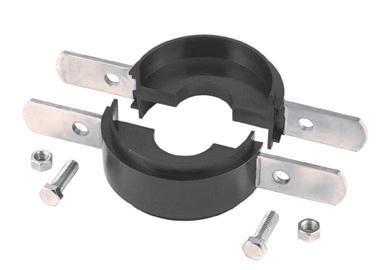
Q uick clearing of soft blockages … and ice By Leah Den Hartogh
Drain cleaning equipment should be part of every plumber’s tool kit. The type of blockage determines what type of machine is best suited to the job.
For the purpose of this article, the focus will be on water jet drain cleaning machines, whose primary function is to clear soft stoppages in pipes, sewers, and other drains. A soft stoppage includes grease, sand, hair build-up, hardened sewage, etc., while a hard stoppage can include things like roots that have to be physically removed with a cable machine. Water jet machines are also used for clearing ice blockages.
“If you are pouring grease down a kitchen sink on a regular basis, that grease is not going to make it out all the way to the municipal system, nor the main system within the building,” noted Dave Dunbar, national sales director with General Pipe Cleaners, McKees Rocks, Pennsylvania.
A plumber must also be wary of “rehealing” grease within a pipe too, which involves only poking a small hole in the grease build-up rather than clearing the full blockage. When you pull a cable out, the grease will close in behind it. A jetter will blast
Electric water jet machines offer considerable flexibility.
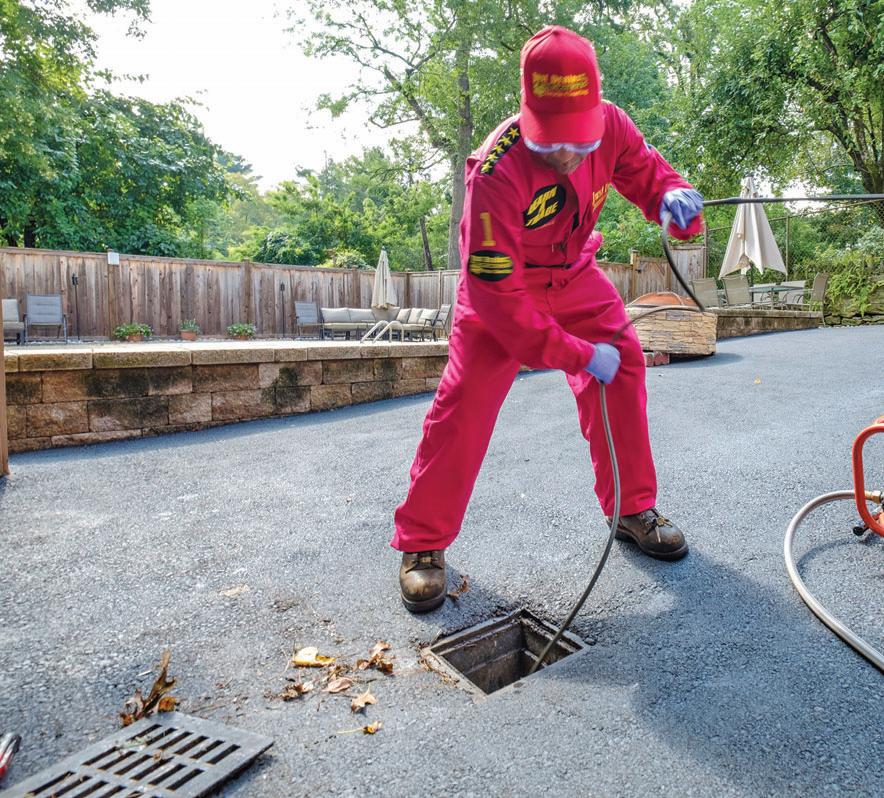
the grease right out of the line.
There are three main types of water jet drain cleaning machines that plumbers use depending on the application – portable electric, gas, and large trailer-mounted jetters.
“We recommend that contractors evaluate the nature of the blockage and select a jetter based on the pressure needed to clear the pipe. It’s also important to select the right head, or nozzle, for the type of blockage, meaning hard versus soft,” said Brendon Goede, underground technologies product manager at Ridgid, Elyria, Ohio. For example, electric jetters are typically used with smaller
Pulse technology helps the hose move down the drain line.
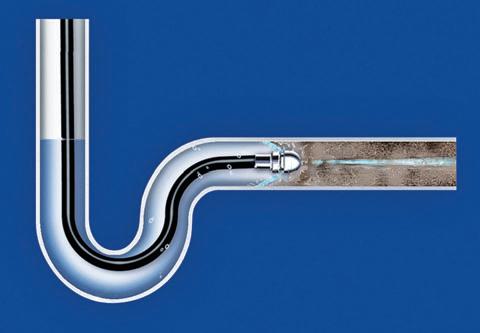
diameter pipes since not as much pressure is required to clear a blockage.
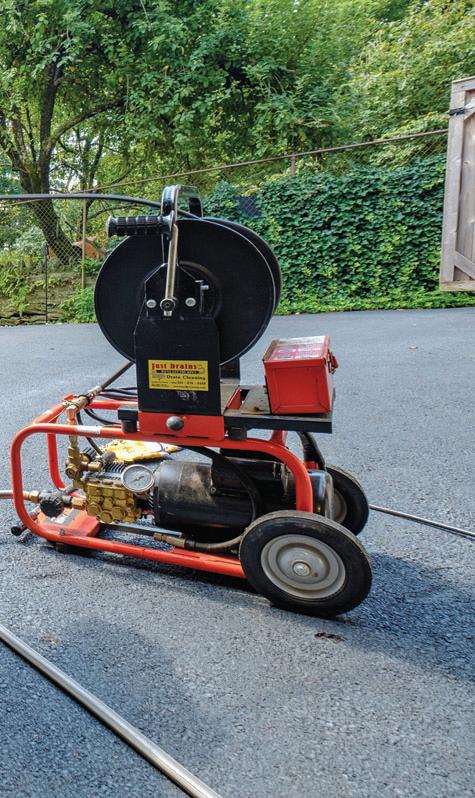
Pressure versus flow
Both flow and pounds per square inch (PSI) are important factors for water jet machines. They go hand-in-hand in terms of cleaning out a soft blockage. If the contractor is looking for wall-to-wall coverage within the pipe, they will want a higher flow rate, said Goede.
It should be noted that some might even think that they can get away with cleaning drains using a common pressure washer, but they don’t work well, warns Dunbar. “After you get to a certain point, and you are in a confined space within the pipe, pressure becomes secondary within the space of the pipe. Flow becomes more important than the PSI.”
In addition, the structural integrity of the piping might determine what type of jetter is required to clear the blockage, reports Goede. Lower pressures should be used on smaller diameter pipes. On the other hand, larger drains over six inches in diameter will require a water jetter that can provide over 2,000 PSI pressure.
How things work
The pump in the jetter creates the constant flow and the nozzle creates the pressure. The idea is to provide good cleaning power but minimize water consumption.
It’s important to note the limitations for each type of jetter. With a small electric machine, “you have to live within the confines of the circuit breaker you are working with,” said Dunbar.
Ridgid offers two electric jetters – KJ-1750 and KJ-1350. The KJ-1350 operates with a working pressure of 1,350 PSI and a flow rate of 1.4 gallons per minute (GPM). It has a 1.5 HP motor and draws a maximum of 14 amps. It can run on most standard 115-volt circuits.
The KJ-1750 has a pressure rating of 1,750 and a flow rate of 1.4 GPM. With a larger two HP motor, it draws a maximum of 17 amps which requires a 20 amp, 115V circuit.
General Pipe Cleaners offers two electric jetters as well. The JM-1000 Mini-Jet gives the plumber 1,500 PSI of cleaning power with a flow rate of 1.4 GPM and only pulls 13 amps. The JM-1450 has the same PSI rating
Please see ‘Drain’ on page 33
Drain cameras and water jet machines go hand-in-hand
Continued from page 31
as the JM-1000 and also only pulls 13 amps; however, it has a slightly higher flow rate of 1.7 GPM.
A gas machine gives the user more power to clear larger diameter pipes and do longer runs. The right flow and pressure for the job isn’t the only thing that a contractor needs to keep in mind. The hose vibrates to help move it down the drain. “If you get a hose stuck in the drain, it’s the beginning of a bad day. Our way of vibrating the hose without hurting the pump is via a cylinder in the pump and it outbalances the pump. We don’t starve any chambers in the pump from water,” explains Dunbar.
Another important tidbit for the contractor to know in terms of limiting how often the jetter might get stuck is: “Forward two feet, back one-foot is the best approach for any size of pipe. Don’t let it sit because the jetter creates this vortex within the pipe. If you don’t move it within 30 seconds, it can impact the head of the jetter and make it stuck. It’s really important to keep the jetter moving.”
The third type of water jetter is the trailer version, which is a large gas-powered machine. General Pipe Cleaner’s trailer jetter has a flow rate of 12 GPM with a PSI rating of 2,500. It is made for larger, longer drain lines or for remote jobs far away from a water source as it has a 200-gallon holding tank.
Cameras and water jetters
Water jet drain cleaning machines and drain cameras go hand-in-hand. It’s a lot easier to see what the problem is with a camera once the drain has been flushed out. While a contractor shouldn’t put the drain camera down while using the water jetter, using the technology before and after can help increase the chances of completely clearing the blockage from the pipe.
“We always say that jetters and cameras go together like peanut butter and jelly. They are good on their own, but better together,” said Dunbar.
When operating a water jet machine, it’s important that the water reservoir not be allowed to run dry, which can damage the pump. Water quality can also be an issue; hard water is not good for the machine. In regions with hard water, plumbers might want to use a water softener to limit the calcium build-up within the machine, warns Goede.
In recent years, nozzle technology has advanced rapidly. “Every time you go to a big trade show you see something different… I am usually surprised when the next innovation comes out. I am sure we
A lightweight portable unit is helpful when you have to haul it up on to a rooftop.

will soon see new innovations. How can I do this job better, quicker, and safer?” said Dunbar. While companies like General and Ridgid offer many nozzle designs for different applications, there are also a number of companies that make specialized nozzles – a separate article for another day! ✚

For larger drains and longer runs, a gasoline engine powered machine makes sense.












